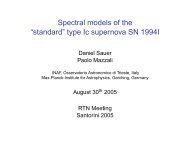Co-Investigator - The Gamma-Ray Astronomy Team - NASA
Co-Investigator - The Gamma-Ray Astronomy Team - NASA
Co-Investigator - The Gamma-Ray Astronomy Team - NASA
- No tags were found...
Create successful ePaper yourself
Turn your PDF publications into a flip-book with our unique Google optimized e-Paper software.
system that meet or exceed these requirements, yetare simple and low risk.A top level block diagram of the Burst Monitor isshown in figure 10. <strong>The</strong>re are 12 NaI scintillationdetectors and 2 BGO scintillation detectors. <strong>The</strong>NaI detectors are 12.7-cm diameter by 1.27-cmthick, directly coupled to a PMT. <strong>The</strong>se detectorsare oriented to provide good sky coverage andperform two functions: 1) Provide spectral coveragefrom about 5 keV–1 MeV, and 2) determine burstlocations using relative rates, similar to BATSE(Pendleton, et al. 1999). NaI is an ideal scintillationmaterial for this energy range combining low cost,Figure 10.—Top level Block Diagram.high efficiency, and adequate spectral resolution.<strong>The</strong> BGO detectors are 12.7-cm diameter by 12.7-cm thick. To provide better light collection, as wellas redundancy, the BGO crystals are directlycoupled to two PMT’s, on opposite sides, whoseoutputs are summed. <strong>The</strong> two BGO detectors areroughly omnidirectional and are positioned onopposite sides of the LAT providing full-sky coverage.<strong>The</strong>y provide spectral coverage from 150 keV–30 MeV. <strong>The</strong> high density of BGO provides goodsensitivity over this difficult energy range. <strong>The</strong> HVof each PMT is separately controlled. In thebaseline design, a single high-voltage power supply(HVPS) box provides 16 separate outputs, whichTable 1.—A traceability matrix showing the GLAST Burst Monitor design characteristics asderived from the scientific goals and constraints.Goal or <strong>Co</strong>nstraintLow-energy spectral measurementsField of view: >~3 steradiansBurst threshold: ~0.5 photons cm –2 s –1Mass: 50 kgPower: 50 W.Telemetry: 10 kbpsBurst MonitorSpectroscopic observations from ~5 keV to ~30 MeV8.6 steradians0.35 photons cm –2 s –1 for 5 σ0.57 photons cm –2 s –1 trigger threshold54.5 kg, with 20% contingency17.8 W. without contingency4 kbps normally, 9 kbps during bursts16



